Unlocking the Power of Lithium Capacitors: A Comprehensive Guide
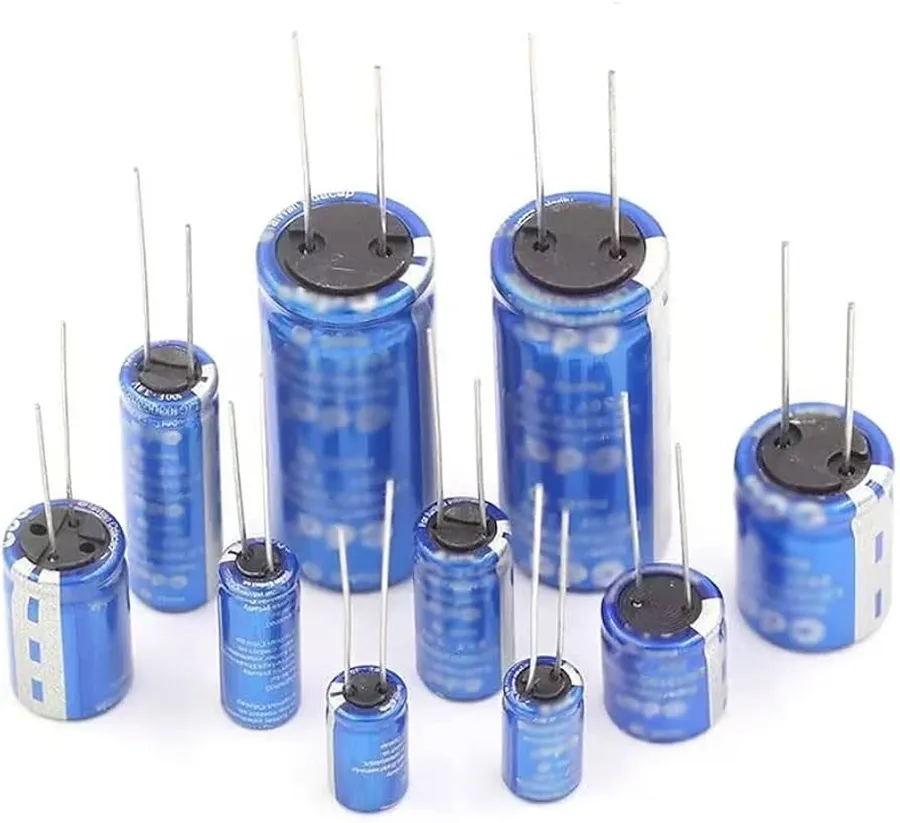
In our ever-evolving quest for efficient energy solutions, lithium capacitors are emerging as a fascinating technology, bridging the gap between traditional batteries and supercapacitors. This article delves deep into the science behind lithium capacitors, how they function, and their potential to revolutionize various industries, making a significant impact on everything from portable electronics to large-scale energy storage solutions. Join us as we unpack the intricacies and applications of this cutting-edge technology.
What is a Lithium Capacitor?

Lithium capacitors are hybrid energy storage devices that bridge the gap between lithium-ion batteries and supercapacitors (also known as electrochemical double-layer capacitors or EDLCs). They uniquely combine the high energy storage capability of lithium-ion batteries with the rapid charge-discharge characteristics of supercapacitors. This is achieved through a distinct architecture that utilizes a lithium-intercalating anode and a high-surface-area cathode, positioning them strategically within the energy storage landscape.
How Lithium Capacitors Work: The Science Behind the Tech
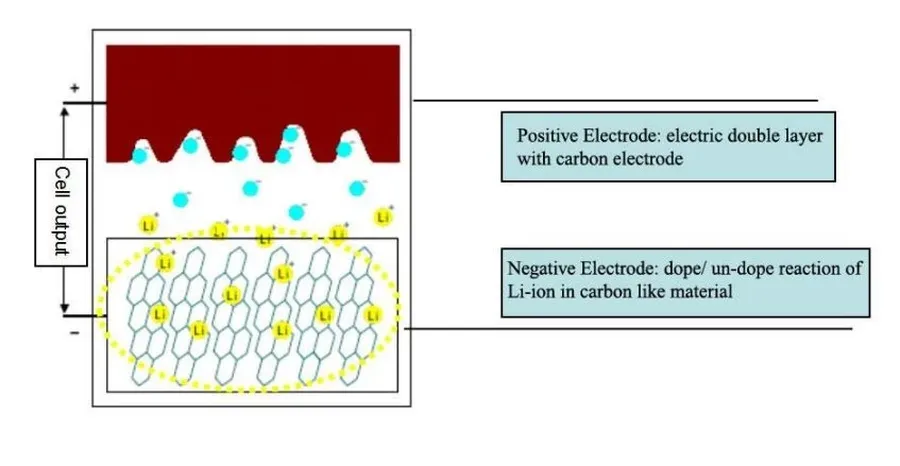
Lithium capacitors operate through a fascinating interplay of electrochemical principles, combining characteristics of both lithium-ion batteries and supercapacitors. Their unique functionality stems from a hybrid architecture where lithium ions are intercalated into the anode material while electrostatic charge accumulates at the cathode, all facilitated by a specialized electrolyte.
At the heart of the lithium capacitor's operation lies a two-electrode system. The anode, typically composed of a material capable of lithium-ion intercalation (similar to lithium-ion batteries), undergoes a reversible chemical reaction where lithium ions are inserted into and extracted from its structure. Simultaneously, the cathode, characterized by a high surface area material, facilitates the electrostatic accumulation of charge, as seen in conventional supercapacitors. This dual process is enabled by an electrolyte, designed to ensure efficient ion transport between the electrodes.
Imagine a busy train station (the capacitor) during rush hour. The lithium ions are like passengers, and the anode is like a train platform where they can board and leave in an organized manner (intercalation). The cathode, on the other hand, is like a large waiting area where passengers can gather quickly (electrostatic charge accumulation). The electrolyte is the system of tunnels that allows the passengers (lithium ions) to move freely and quickly between the platform and the waiting area, ensuring that the system can charge and discharge rapidly. When the capacitor is charging, lithium ions are transferred from the cathode to the anode. During discharge, the process is reversed, and the lithium ions are transferred back. The amount of lithium that can be stored is similar to a battery, but the speed at which the lithium ions move is more similar to a capacitor.
The electrolyte plays a crucial role by enabling ion mobility and maintaining electrochemical stability. It must exhibit high ionic conductivity, low electronic conductivity, and chemical inertness. The performance of a lithium capacitor is highly dependent on the selection of suitable electrolyte materials to facilitate efficient charge storage.
Advantages of Lithium Capacitors
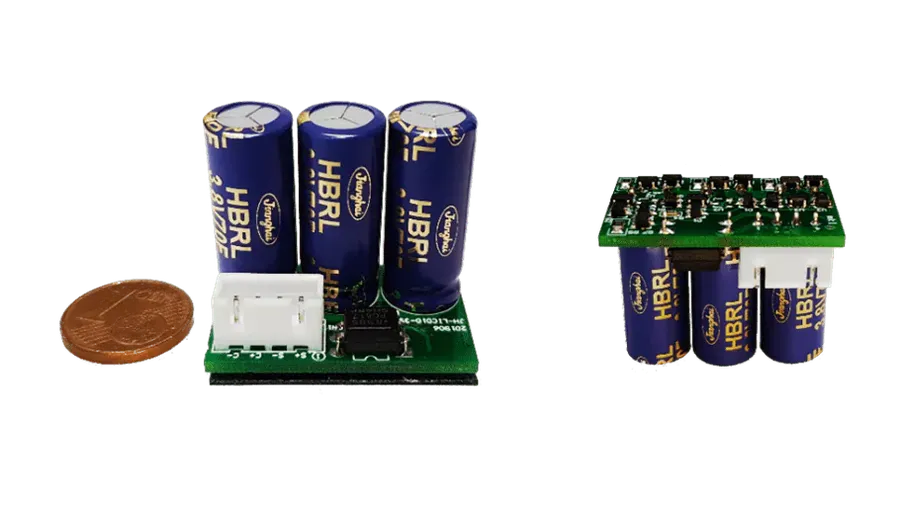
Lithium capacitors distinguish themselves through a compelling combination of performance characteristics that position them advantageously in various energy storage applications. These advantages stem from their unique hybrid architecture, blending the strengths of both lithium-ion batteries and supercapacitors.
- High Power Density
Lithium capacitors exhibit significantly higher power density compared to lithium-ion batteries. This enables them to deliver bursts of energy rapidly, making them suitable for applications demanding quick power delivery such as start-stop systems in vehicles and power tools. - Rapid Charge/Discharge Rates
They can be charged and discharged much faster than lithium-ion batteries, often in a matter of seconds or minutes. This is crucial in applications where quick energy cycling is essential, such as regenerative braking systems. - Long Cycle Life
Lithium capacitors boast a superior cycle life compared to batteries, often exceeding hundreds of thousands of cycles with minimal degradation. This exceptional longevity reduces the need for frequent replacements, thereby lowering overall operational costs. For instance, in energy harvesting applications, lithium capacitors can consistently perform over the lifespan of the device without needing replacement. - Wide Temperature Operating Range
Lithium capacitors can operate efficiently across a broad range of temperatures, from very low to relatively high temperatures. This is vital for devices operating in diverse environments and extreme conditions where conventional batteries face performance limitations. - Enhanced Safety
While not inherently immune to safety concerns, lithium capacitors are generally safer than lithium-ion batteries. They do not suffer from thermal runaway, which is a significant hazard in lithium-ion battery technology. This enhances overall safety, making them suitable for applications where safety is a paramount concern, such as in portable electronic devices and medical equipment.
These benefits make lithium capacitors suitable for applications where rapid energy delivery, longevity, and reliability are paramount. Consider energy harvesting systems, where their rapid charge capabilities efficiently store energy from ambient sources, or in automotive start-stop systems where their ability to quickly provide power to restart the engine can save fuel. Their long cycle life, even in high-demand applications, makes lithium capacitors more reliable for longer periods without frequent replacement. These use cases represent a compelling value proposition for lithium capacitor technologies.
Lithium Capacitor vs. Lithium-ion Battery: Key Differences
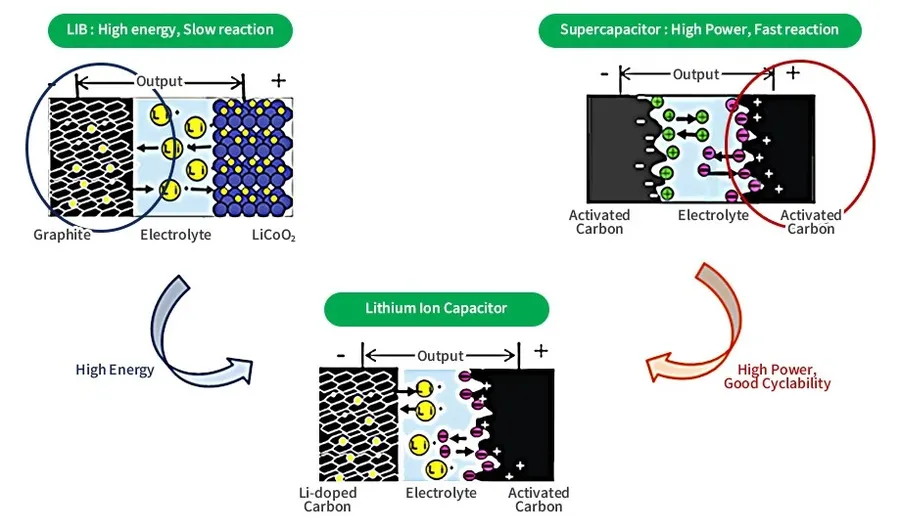
Lithium capacitors and lithium-ion batteries represent distinct energy storage technologies, each with unique characteristics suiting different applications. While both utilize lithium ions for charge transfer, their operational mechanisms, performance profiles, and optimal use cases differ significantly. Lithium capacitors, as hybrid devices, prioritize power delivery and longevity, while lithium-ion batteries are tailored for higher energy storage.
| Feature | Lithium Capacitor | Lithium-ion Battery |
|---|---|---|
| Energy Density | Lower (5-10 Wh/kg) | Higher (100-265 Wh/kg) |
| Power Density | Higher (up to 10 kW/kg) | Lower (0.2-1 kW/kg) |
| Cycle Life | Very High (>500,000 cycles) | Moderate (500 - 2,000 cycles) |
| Charge/Discharge Rate | Very Fast (seconds to minutes) | Slower (minutes to hours) |
| Voltage Characteristics | Linear voltage drop during discharge | Relatively stable voltage during discharge |
| Safety | Generally safer, lower risk of thermal runaway | Potential for thermal runaway if mishandled |
| Primary Application | Applications requiring high power bursts, rapid charging/discharging, and long life | Applications requiring high energy storage capacity |
| Cost | Higher per unit of energy storage | Lower per unit of energy storage |
Lithium Capacitor vs. Supercapacitor: What's the Catch?
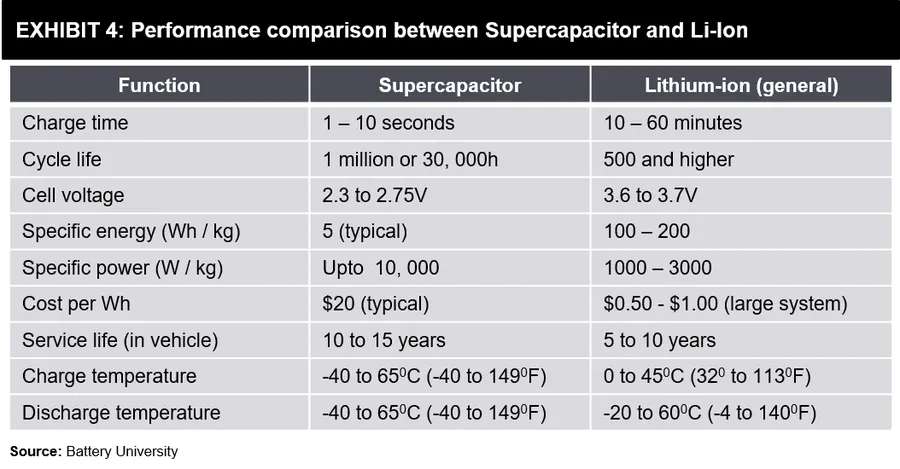
Lithium capacitors effectively bridge the performance gap between traditional supercapacitors (also known as ultracapacitors) and lithium-ion batteries, offering a unique blend of characteristics. While supercapacitors excel in power density and cycle life, they typically lag in energy storage capacity compared to batteries. Lithium capacitors address this limitation by incorporating battery-like materials and mechanisms, resulting in a superior energy density compared to supercapacitors, without sacrificing their high power and long cycle life.
| Characteristic | Supercapacitor (EDLC) | Lithium Capacitor |
|---|---|---|
| Energy Density | Low | Medium |
| Power Density | High | High |
| Cycle Life | Very High (100,000+ cycles) | High (10,000+ cycles) |
| Charge/Discharge Rate | Very Fast | Fast |
| Voltage Characteristics | Linear voltage drop during discharge | Voltage drop profile is less linear |
| Cost | Generally lower | Generally Higher |
Applications of Lithium Capacitors: Where Are They Used?
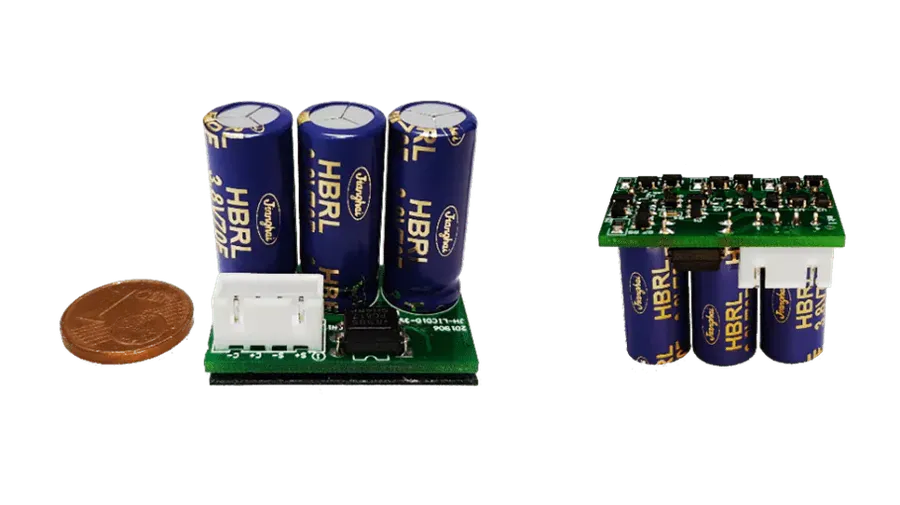
Lithium capacitors, with their unique blend of high power density and extended cycle life, are finding applications across diverse sectors. Their ability to rapidly charge and discharge, coupled with their enhanced safety profile compared to traditional batteries, makes them ideal for various emerging technologies and demanding applications. These applications range from portable devices to large-scale energy storage solutions.
- Energy Harvesting
Lithium capacitors excel in energy harvesting systems, where they efficiently store energy captured from ambient sources like solar, thermal, or kinetic energy. Their rapid charge/discharge capability allows them to quickly absorb energy bursts and provide a stable power supply for low-power devices, sensors, and wireless communication nodes. For example, small solar powered sensors for remote environmental monitoring can leverage the energy storage provided by lithium capacitors. - Portable Electronics
In portable electronic devices, lithium capacitors are gaining traction as a power source for applications requiring quick bursts of power. Examples include camera flashes, audio amplifiers, and handheld power tools. Their high power density enables smaller form factors and faster operational cycles compared to batteries in such devices. - Automotive Auxiliary Power
Lithium capacitors are finding increased usage in automotive applications, particularly in start-stop systems. Their high charge/discharge rates allow for efficient energy recapture during braking, thus improving fuel efficiency and reducing emissions. These capacitors handle the power demands of frequent engine restarts without degradation, unlike lead-acid batteries which are the traditional solutions. - Grid Stabilization
The ability of lithium capacitors to provide rapid power delivery makes them ideal for grid stabilization applications. They can help regulate frequency fluctuations and provide short-term power support during peak demand. For example, in microgrids, lithium capacitors can play a crucial role in balancing power generation with the grid needs, improving overall grid stability. - Backup Power Systems
Lithium capacitors serve as highly efficient backup power sources for critical systems that demand reliable and immediate power during outages. They provide a more robust and reliable backup compared to conventional batteries due to their higher cycle life and rapid response times. Applications include data centers, industrial control systems, and emergency lighting systems, where a consistent and dependable backup power is critical.
The Future of Lithium Capacitors: Trends and Innovations
The trajectory of lithium capacitor technology is marked by ongoing research and development aimed at enhancing performance, reducing costs, and expanding application horizons. This involves material science innovations, novel cell designs, and improved manufacturing processes, all geared towards realizing the full potential of these hybrid energy storage devices.
Current research focuses on several key areas:
- Advanced Materials for Electrodes
Scientists are exploring new materials for both the anode and cathode to increase energy density and power density, such as using graphene, MXenes, and other nanomaterials. These materials can offer improved conductivity, surface area, and ion diffusion rates. - Novel Electrolytes
Development of new electrolytes with improved ionic conductivity, wider electrochemical windows, and enhanced safety is crucial. Solid-state and gel electrolytes are also being considered to address safety concerns associated with liquid electrolytes. - Cell Design Optimization
Innovations in cell design, such as 3D architectures, aim to maximize electrode surface area and minimize ion transport distances, improving performance. These designs can also be tailored to specific applications. - Manufacturing Process Improvements
Cost reduction and scalability are critical for widespread adoption. Research is being conducted to streamline manufacturing processes, reduce waste, and enhance production efficiency. This includes exploring continuous and roll-to-roll manufacturing techniques.
These advancements are anticipated to have a significant impact across various industries, including:
- Automotive
Improved lithium capacitors with higher energy density could enable better regenerative braking and more efficient start-stop systems, and even potentially support hybrid vehicles. Lower cost and improved performance will enhance their adoption. - Renewable Energy Storage
As renewable energy becomes more prevalent, lithium capacitors can play a crucial role in grid stabilization and energy storage applications. Their rapid charge and discharge characteristics are very useful for dealing with fluctuations in energy supply. - Portable Electronics
Smaller, lighter, and more efficient lithium capacitors can improve battery life, reduce charging times, and enhance the user experience. - Industrial Equipment
Lithium capacitors can power industrial equipment, offering long cycle life, minimal maintenance, and consistent performance in harsh environments.
As research and development continues, lithium capacitors are poised to become an increasingly important component of future energy solutions, offering a compelling combination of power, speed, longevity, and safety. They will occupy a more distinct niche in the energy storage landscape, different from both batteries and supercapacitors.
Frequently Asked Questions About Lithium Capacitors
This section addresses common inquiries about lithium capacitors, clarifying their characteristics, limitations, and applications compared to other energy storage technologies. The aim is to provide clear, concise answers based on established scientific and engineering principles.
- Is lithium used in all types of capacitors?
No, lithium is not a component in all capacitors. Traditional capacitors primarily use materials like ceramic, tantalum, or aluminum. Lithium is specifically used in lithium-ion batteries and more recently in hybrid devices like lithium capacitors, which combine elements of battery and supercapacitor technology. - What are the main limitations of lithium capacitors?
While lithium capacitors boast high power density and rapid charge/discharge rates, they typically have lower energy density compared to lithium-ion batteries. This means they can't store as much energy per unit mass or volume. They also have a relatively higher cost and limited market maturity compared to other storage solutions. - How is a lithium capacitor charged?
Lithium capacitors are charged using a controlled voltage source, similar to supercapacitors, and typically utilize a constant current-constant voltage (CC-CV) charging regime. Unlike batteries, they do not involve chemical conversion during charging. Instead, ions move between electrodes accumulating a charge, allowing for faster charging times and many more charge/discharge cycles compared to batteries. - Why aren't lithium capacitors used instead of batteries in every application?
The primary limitation that prevents lithium capacitors from universally replacing batteries is their relatively low energy density. Batteries store more energy, making them suitable for applications needing long periods of sustained power. Lithium capacitors, with their high power density, are ideal for applications that require rapid power bursts and frequent charging/discharging cycles rather than sustained energy storage. - Are lithium capacitors safe?
Lithium capacitors generally exhibit higher safety characteristics than lithium-ion batteries due to their unique hybrid design and the absence of highly reactive chemical transformations during operation. However, like all energy storage devices, they are not without risks and must be handled according to manufacturer's recommendations. - What is the key difference between a lithium capacitor and a supercapacitor?
Lithium capacitors are a hybrid technology bridging the gap between supercapacitors (EDLCs) and lithium-ion batteries. They use a lithium intercalation anode (like batteries) and a high surface area cathode (like EDLCs), which enhances energy storage and power density compared to traditional supercapacitors. Traditional supercapacitors rely on an electrostatic double layer for charge storage and do not involve chemical intercalation of lithium ions. - What are the key advantages of lithium capacitors over other energy storage solutions?
The key advantages of lithium capacitors include rapid charge/discharge capabilities, higher power density, longer cycle life, and a broader temperature operating range when compared to traditional batteries. They offer a combination of the high-power characteristics of supercapacitors and some of the energy storage capacity of batteries, making them suitable for a range of specific applications.
Lithium capacitors represent a significant leap forward in energy storage technology, offering a compelling alternative or complement to both traditional batteries and supercapacitors. Their unique blend of high power density, rapid charge rates, and extended cycle life positions them as a key enabler for a wide array of applications, from enhancing our daily devices to building more sustainable energy grids. While still evolving, the future of lithium capacitors appears exceptionally bright, promising to reshape how we generate, store, and utilize energy. As research progresses and costs continue to decline, expect to see lithium capacitors become an ever-more integral part of our technological infrastructure.
 AnyPCBA
AnyPCBA